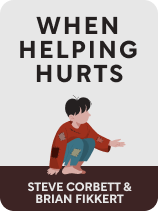

This article is an excerpt from the Shortform book guide to "When Helping Hurts" by Steve Corbett and Brian Fikkert. Shortform has the world's best summaries and analyses of books you should be reading.
Like this article? Sign up for a free trial here.
What are short-term mission trips? Why might these trips be unethical?
In short-term mission trips, missionaries move for a short period to spread God’s word and help others in need. However, these intentions often hurt people since the missionaries neglect to give people what they really need to thrive.
Let’s look at the history of short-term mission trips and how everybody can get the most out of these trips.
History and Risks of Short-Term Missions
According to Steve Corbett and Brian Fikkert in When Helping Hurts, short-term mission trips (STMs) have been a popular approach to poverty alleviation since 1989. STMs typically last two weeks or less, during which time a team of volunteers travels to a community in need to provide assistance. Historically, they’ve been fueled by positive press praising their impact, particularly the impact on the missionaries themselves.
However, Corbett and Fikkert argue that in reality, STMs frequently embody many of the issues we’ve already discussed regarding harmful approaches to poverty alleviation, such as paternalism, cultural superiority, the inappropriate application of relief, and need-based approaches. Volunteers participating in an STM don’t stay around long enough to see the long-term impact of their work, potentially making them oblivious to the harm that they can cause to the people they’re trying to help or to local ministries that are trying to help the same people.
Planning a Mission
To mitigate these risks, the authors insist that when planning or considering an STM, you should refrain from developing your own mission itinerary using limited information about the situation and culture in the destination area and instead prioritize assisting local ministries in the destination area. Generally, local communities already have ministries that are doing impactful work. And local ministries are in a much better position to plan, execute, and evaluate effective interventions due to their integration into the affected community.
Depending on the situation, this may mean forgoing the STM altogether, if a visiting team of volunteers is not what the local ministry needs. The authors advise against organizing an STM unless the local ministry organization specifically requests or invites you to send a team. So you might not get to experience helping with the intervention first-hand, but, as Corbett and Fikkert point out, the mission isn’t about you—it’s about helping people in need. Sometimes you can help them more by staying out of the way of those who can help them the most.
Radical Short-Term Missions
The spirit of the STM movement is exemplified by pastor David Platt in his book Radical: Taking Back Your Faith From the American Dream, in which, among other things, he challenged Christians to spend at least two percent of their time in “another context,” such as an impoverished community overseas.
Platt argues that this experience is crucial for cultivating an understanding of the global church and for developing Christian compassion because once you start visiting people who are destitute, you can’t ignore the problem of poverty anymore. And two percent of your time is about one week per year, or one STM every one to two years.
Nevertheless, despite his insistence on the importance of regular participation in STMs, Platt acknowledges that Corbett and Fikkert are right about the risks and the solutions to mitigating the risks and alleviating poverty. The 2012 edition of When Helping Hurts included a foreword by David Platt, praising Corbett and Fikkert’s work.
Frame STMs as Learning Experiences
If you do determine that an STM is appropriate, Corbett and Fikkert suggest presenting the trip as an opportunity to learn about mission work or poverty alleviation in the destination area, not an opportunity to save others from disaster or poverty. To that end, they advise that everyone who goes on the trip be required to attend training sessions before and after the trip.
Pre-trip training should provide an overview of poverty alleviation principles, team-building exercises, cultural orientation, and basic language skills if the people in the destination area speak a different language. In addition to preparing team members for the trip, the mandatory pre-trip training will help to filter out anyone who’s not committed to learning on the trip.
In the field, the authors say you should take time to review concepts from the pre-trip training with the team so they can better understand how to apply them or how what they’re doing on the trip relates to what they’ve learned beforehand.
According to Corbett and Fikkert, mandatory post-trip training should continue for at least a year after the team returns. The post-trip training gives team members a chance to reflect on the trip and process what they learned into lessons that will shape how they approach poverty alleviation in the future.
Finally, the authors recommend keeping the size of the team relatively small, to further mitigate the risk of unintended negative impact. The mandatory training contributes to keeping the team small. They also recommend requiring involvement in your church’s local poverty alleviation efforts as a prerequisite for going on the trip. And they insist that every team member pay at least a portion of their own travel expenses out of pocket. This not only deters people who are less committed but will also make the trip more valuable to those who do go because they have more vested in the trip.
Getting the Most Out of STMs Through Training
As we’ve seen, Corbett and Fikkert recommend mandatory training for anyone who participates in an STM, both to make sure that the people who go on the trip get the most out of it and to weed out people who aren’t fully committed.
In addition to the content Corbett and Fikkert recommend covering in the training, other sources provide some additional recommendations for elements of training that can help the trip go smoothly and ensure you get the most out of it.
Some sources add safety and security precautions to the pre-trip training itinerary. They emphasize that traveling abroad always entails some risk, but that there are simple things you can do to minimize the risks. For example, simply staying alert and knowing enough about the culture that you can fit in instead of standing out as an easy victim goes a long way toward mitigating the risk of being robbed.
And during the post-trip training, consider writing up an account of your trip to post on social media, maintaining contact with the indigenous people you met on the trip through social media or correspondence, and planning your next step based on what you’ve learned, whether your next step is another trip, a commitment to support someone else’s work financially, or something else.

———End of Preview———
Like what you just read? Read the rest of the world's best book summary and analysis of Steve Corbett and Brian Fikkert's "When Helping Hurts" at Shortform.
Here's what you'll find in our full When Helping Hurts summary:
- How many Christian church missions actually do more harm than good
- A look into the true nature and causes of poverty
- Suggestions for how to help the poor more effectively






